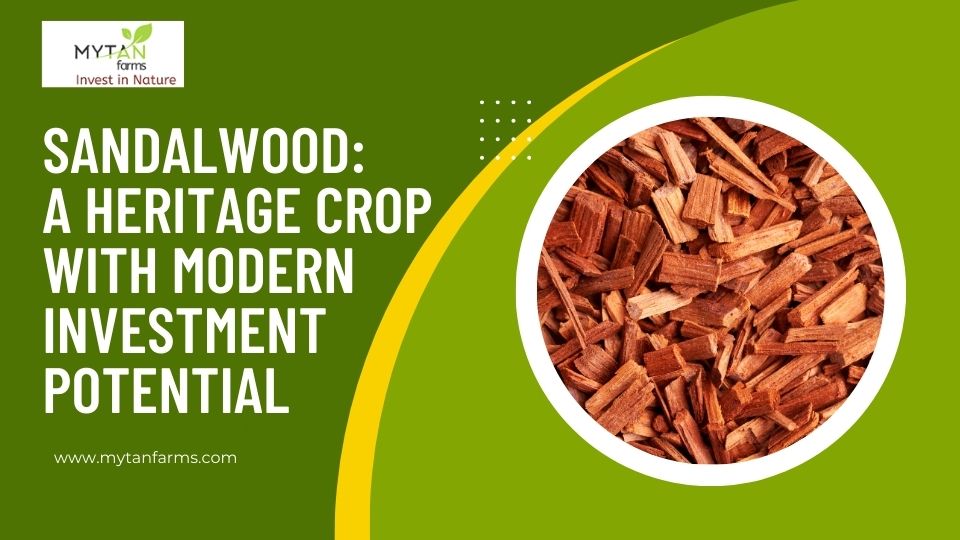
Due to the beautiful heartwood and historical background, this much-sought-after resource in perfumery, traditional medicine, and religious practices crosses many generations. Once harvested excessively and endangered, sandalwood is now regaining its status in the world market not only as a luxury commodity but also for its Sandalwood Investment Potential.
As demand for sustainable products grows, investing in sandalwood presents a unique opportunity for those seeking both profitability and environmental responsibility.
Managed farmland in Karnataka plays a crucial role in this resurgence, offering investors a chance to engage in sandalwood cultivation within a structured and sustainable framework. As growing knowledge of its uses combines with new cultivation practices, sandalwood represents a unique opportunity for modern investors seeking to blend profitability with environmental stewardship.
The Sandalwood Market Today
Global Demand Trends
The market for sandalwood has seen a significant resurgence due to the ever-growing consumer preference for products that are considered natural and organic. There is brisk demand across the globe for sandalwood, and reports show that the market will experience a compound annual growth rate of over 10% in the coming years. Pure sandalwood oil is going into increasing demand as international standards get tougher on synthetic fragrances and ingredients.
Major Markets: Perfumery, Aromatherapy, Traditional Medicine
Sandalwood is mainly used in several markets. For perfumes, it is considered to be of high grade because of its intense, woody fragrance—it’s a base note perfume that is used to strengthen many different fragrances. Aromatherapy values it not only for its calming nature but also as a method for alleviating stress and inducing relaxation. Traditional medicine has also held reverence for sandalwood’s anti-inflammatory, antiseptic, and astringent properties aside from its flavor in various health products.
Price Evolution Over the Past Decades
Sandalwood is quite an unstable market for the commodity’s price over the years. Indeed, the market value for sandalwood increased from a few dollars per kilogram to up to $ 300 per kilogram in the last three decades. The reasons cited are because the supply of wild sandalwood is getting scarce and the therapeutic and ecological benefits of it are getting to be well-recognized.
Why Sandalwood as an Investment

Long-Term Appreciation Potential
In investment in sandalwood, there is excellent long-term appreciation. Considering natural limited resources becoming scarce, the demand for farm-raised sandalwood will surely increase, especially high quality varieties like Santalum album.
Diversification Benefits in an Investment Portfolio
Sandalwood is an alternative asset class where investors diversify their portfolios since the traditional stocks and bonds may become volatile. Thus, the ability to cushion effects from general economic downturns or even the rise of inflation due to the investment in the sandalwood.
Renewable Resource with Multiple End-Uses
Sandalwood is a renewable resource and has multiple end uses ranging from the essential oils right up to incense as well as wood craft. That multiplicity enhances commercial viability, hence attractive as a long-term investment.
Cultivation and Growth Cycle
Ideal Climate and Soil Conditions
Sandalwood is suited to tropical and subtropical weather conditions and prefers sandy soils with a pH of 5 to 6. Suitable countries for planting sandalwood are India, Australia, and Indonesia.
Growth Stages and Care Requirements
There are different growth stages of sandalwood trees, from the seedling up to mature trees. In the initial stage, proper care involves providing sufficient water, providing nutrients, and removing pests as the plants are sensitive during their first stages.
Harvest Cycle (15-20 Years to Maturity)
Unlike some other plants, the sandalwood tree doesn’t become ripe overnight. In most cases, the gestation period for harvesting at a profit is around 15 to 20 years. That is what makes the investment in sandalwood challenging but worthwhile.
Sustainable Harvesting Techniques
To be sustainable, harvesting of sandalwood should be less destructive. Newer inventions support selective cutting that will allow regeneration as well as satisfaction of market demands for the near term at least, keeping business aspects in tune with environmental concerns.
Investment Models
Direct Land Purchase and Cultivation
Buying the land directly affords the investor complete control over both growth and selling processes. It requires the investor to be familiar with sandalwood farmland near Bangalore management and market conditions.
Managed Sandalwood Plantations
For those less keen on direct farming, investment in managed sandalwood plantations offers an alternative that is more appealing. Instead, the investor finances existing plantations where professional managers manage the plantation, and hence a much more passive investment.
Sandalwood-Based Financial Instruments (e.g., Commodity Futures)
Another exciting investment channel is financial instruments based on sandalwood, including commodity futures. These permit speculation upon the future price of sandalwood without requiring any actual ownership.
Joint Ventures with Established Growers
Combining capital with expertise and forming joint ventures with established growers helps in combining capital with expertise. This model allows for the know-how transfer process and better alignment of interest with market demands.
Challenges and Risks

Regulatory Environment and Export Restrictions
The sandalwood industry is most regulated, especially as far as harvesting and exporting is concerned. It is one’s way of keeping far from lawlessness and may affect profitability.
Threat of Diseases and Pests
Diseases and pests are the major threats to the growth of sandalwood. Investors must keep abreast of the best agricultural practices to minimize the risks.
Market Price Fluctuations
Though sandalwood presents increasing price growth, market volatility can hamper profitability. The already competitive volumes face a squeeze in terms of macroeconomic conditions and synthetic substitutes.
Long Gestation Period
A long gestation period is induced by the requisite 15-20 year maturation period that the tree requires to attain maturity. Therefore, investors can wait for 5 years or more to witness any payback.
Sustainability and Conservation
Role in Reforestation Efforts
Sandalwood farming is a way of reforestation that offers ecologic benefits to degraded ecosystems. Re-afforestation is one of the win-win circumstances wherein biodiversity enhancement goes along with a profitable crop.
Protecting Native Sandalwood Species
Sustainable cultivation, therefore, also means native sandalwood conservation since they should be farmed in such a manner that their cultivation does not pose further threats towards the wild populations.
Balancing Commercial Interests with Ecological Preservation
Investors must make compromises between the pursuit of such profits and nature, which will be conserved with sustainable cultivation practices. Sustainable cultivation ensures that both profit-making and the health of the environment can be compatible.
Technology in Sandalwood Farming

Advanced Cultivation Techniques (Tissue Culture, Grafting)
Advancements in farming techniques, such as tissue culture and grafting, may enhance growth rates and improve quality yield for sandalwood.
Precision Agriculture for Optimal Growth
Application of technology in farming, such as drone mapping and soil sensors, enable monitoring of the development of growth conditions in real-time, thus allowing interventions on time to improve on sandalwood sandalwood cultivation.
Blockchain for Supply Chain Transparency
Application of blockchain increases the chains in transparency of supply in sandalwood. The blockchain would increase the heights of consumer trust, which could lead to a high level of compliance in the sustainability standards.
Case Studies
Successful Stories: Australian Sandalwood Network
The Australian Sandalwood Network is pivotal to the industry, and the network is fostering sandalwood of quality while popularising sustainable farming practices.
Indian Sandalwood Projects in Northern Territory, Australia
Projects undertaken in Australia’s Northern Territory have proved the viability of cultivating Indian sandalwood. Such initiatives reflect progressive practices that are not merely profitability-driven but also offer ecological benefit.
Lessons from Failed Ventures
Although some of the investments in sandalwood did not pay off, review of such failed past investments can enlighten a potential investor on the use of risk control and dynamics of the market. Knowing mistakes, for instance, lacked thorough studies in the market and environmental ignorance is extremely important guidance for other investors.
Future Outlook
Emerging Markets in China and the Middle East
China and the Middle East are other potential developing markets in sandalwood as high-income consumer markets demand luxury goods and natural products and, therefore, very likely to fuel demand.
New Applications in Cosmetics and Nutraceuticals
Apart from traditional applications, the use of sandalwood in cosmetics and nutraceuticals is dramatically increasing. This creates new avenues for market.
Potential Impact of Climate Change on Cultivation Zones
Climate change threatens the cultivation zone of sandalwood. With the increase in temperature, cultivation techniques need to be altered with changing geographical zones also.
How to Get Started
Conducting Thorough Market Research
Prospective investors should carry out proper research in the markets to understand the prevailing trends, potential risks, and opportunities within the sandalwood industry.
Evaluating Different Investment Options
The investor needs to evaluate the available models of investment, either direct ownership, managed plantations, or financial instruments, to determine which one is suitable for them
Understanding Legal and Financial Implications
Laws govern sandalwood farming chiefly in India. The government also regulates its harvesting and trade. The investor should be aware of the legal practices, from land ownership restrictions to taxations, export rules, etc. A financial consultant can help demarcate cost structure as well as plausible tax benefits before investment.
Importance of Expert Consultation
Associations with experts in agriculture, consultants, and lawyers are highly crucial to ensure a good investment in sandalwood. They will gain an insight into the techniques used to cultivate it, the compliance of environmental laws, and other market trends. Such an opportunity for investment is offered by companies like Mytan Farms; they make the whole process much easier, helping them guide one through, providing infrastructures as well as professional management for many decades of experience.
Conclusion
Sandalwood is one of the heritage crops that offers an opportunity to blend heritage crop farming with modern investment potential. Projects related to Sandalwood Farming in India, such as those represented by Mytan Farms near Bangalore, come with a well-structured approach to investing in this lucrative and sustainable industry. With proper research, guidance on laws, and consultations with experts, investors are well-positioned to secure their share in the rapidly growing demand for sandalwood while contributing to both environmental and economic sustainability.




